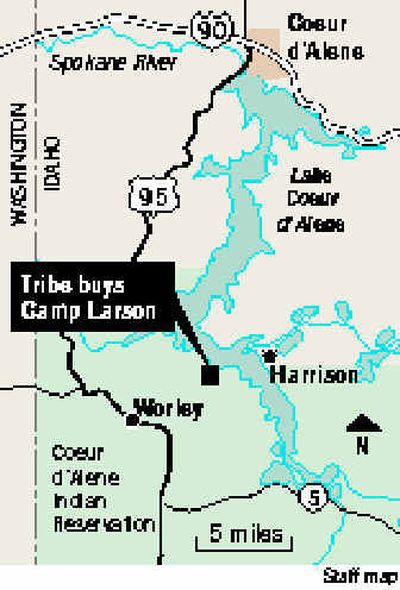Tribe gets place on lake

WORLEY, Idaho – For more than a century, everybody but the Coeur d’Alene Tribe got their piece of Lake Coeur d’Alene’s shore.
Now the Coeur d’Alenes have gotten a piece back – 36 acres and 700 feet where the land meets the water.
“We have returned,” said Felix Aripa, a longtime tribal elder. “We’re stepping on our soil again.”
On Wednesday, the tribe celebrated the purchase of Camp Larson, a longtime Washington State University facility for disabled children that the school sold to the Coeur d’Alenes for $1 million.
The tribe plans to use the land to launch a program with WSU for tutoring, teacher recruitment and other efforts designed to improve education for tribal children. Among the initiatives will be scholarship programs to WSU for Coeur d’Alene students – no tribal member is currently enrolled at the school, officials said.
“We see it as a model that might allow us and others to create a cutting-edge partnership with other tribes,” said WSU Provost Bob Bates, who will oversee the collaboration for the university.
The Cottonwood Bay land is among the tribe’s first purchases of waterfront property on the lake, which was the center of the Coeur d’Alenes’ lives for generations before the westward expansion of the United States drove tribes from ancestral lands.
“The Coeur d’Alene Tribe did not leave our lake behind,” said Francis SiJohn, vice chairman of the tribe. “We did not abandon our lake.”
Aripa said the land was used as a place to drive game for easier hunting, and that the lake and rivers in the area were crucial to the tribe’s lives.
“That was our livelihood, because all the animals would come down to this area,” he said.
By the time WSU professor Roger Larson bought the land, the Coeur d’Alenes had been separated from it for a couple of decades. Larson and some other professors bought the camp in the 1950s and sold it to WSU as a summer retreat, primarily for children with disabilities.
In recent years, however, the school has had less use for the property, and paying for upkeep became more costly, said Greg Royer, WSU’s vice president for business affairs.
Royer said it would have cost about $5 million to bring camp facilities, including a mess hall and 25 other buildings, up to government standards.
The school decided to sell. The scarce and highly desirable lakefront parcel could easily have landed in other hands. Interested parties included resort developers and a couple of Seattle doctors looking for lake homes, Royer said. But when the tribe’s interest became known, university officials took immediate notice.
“We just thought it was the right thing to do to get it back in the hands of the Coeur d’Alene Tribe,” Royer said.
The deal was pulled together last fall, and school and tribal officials have been developing a plan for educational programs at the camp. In addition to spending $1 million for the land, the tribe will spend that much again over the next five years on the educational programs.
To begin, the tribe and university will assess the education needs of the tribe and develop specialized tutoring. Youth sports programs, WSU scholarships for tribal students, teacher recruitment and cultural sensitivity workshops are all part of the plan now, according to the tribe.
Activities will begin this summer, and the tribe and university will review the programs over time, said Marjorie Zarate, director of education for the Coeur d’Alene Tribe. Tribal officials don’t yet know what the camp will be called.
About 100 people gathered at the camp Wednesday to celebrate the announcement, which was punctuated with drumming and songs, a prayer and presentations from the tribe and WSU.
“I want to express our delight that we were able to work out an agreement where these ancestral lands are now returned to the Coeur d’Alenes,” said WSU President Lane Rawlins. “The Creator was good to this spot of land.”
During his prayer at the ceremony, Cliff SiJohn said that more than 100 years ago, the Coeur d’Alenes had camps all around the lake, which had sustained them “for generation upon generation upon generation.”
“We bathed our babies in the morning in the water,” he said. Now, “we will be able to bathe our babies in these waters again.”